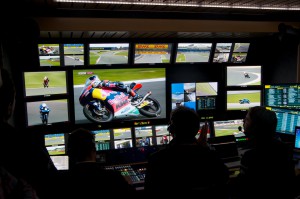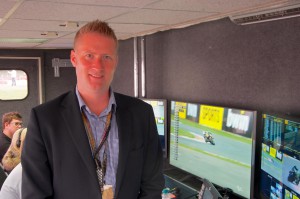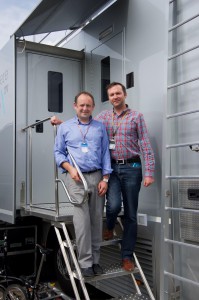Live from Silverstone: BT Sport and Dorna Sports rack up MotoGP firsts for Ultra HD
Last weekend’s Octo British Grand Prix at Silverstone was the first time a MotoGP World Championship event was broadcast live in Ultra HD; the first time 4K super slo-mo was used on a live sports production; and the first time a UHD wireless camera system was used on a broadcast (see separate article). It was also “the biggest event that MotoGP has ever done,” said Jamie Hindhaugh, Chief Operating Officer, BT Sport and BT TV, with 160 cameras covering the event, 19 of which were UHD.
The BT Sport UHD channel was launched on August 1 and Silverstone was its fifth live event (the rest were all football). It was a collaboration between Dorna Sports (which produces all MotoGP coverage worldwide) and BT Sport, with Timeline providing the facilities and North One Television taking care of the HD production for BT.
Dorna provided all the camera operators and the OB directors for both the HD and UHD production, as “there is a certain way that you shoot motor sport and racing” and it would have been counterproductive not to take advantage of their expertise, said Hindhaugh.
North One does a lot of motorsport programming, and has produced MotoGP for BT Sport for two years. At Silverstone it had 22 hours of live coverage (Friday, Saturday and Sunday), including all the features, interviews, analysis and behind the scenes material, then taking Dorna’s qualifying and race coverage. While BT covered the racing in UHD, all of the surrounding material from North One was up-rezzed from HD. “Ultimately it would be great to produce the whole thing in 4K, and that is the goal for everybody, long term,” said Neil Duncanson, CEO, North One Television.
Super slow motion
Silverstone was the first time BT used the I-Movix 4K slow motion system for UHD, although Dorna tested it for the MotoGP last year, and BT has also used it in tests for rugby and football. “The pictures are absolutely stunning,” said Andy Beale, Chief Engineer, BT Sport. “On a sunny day, at a complex corner, when the bikes change from left to right, it looks amazing. The detail you can see. You can read the scrutineer’s signature and the barcode ID number on the side of the fuel tank.”
Previously, when Dorna has used slo-mo it hasn’t used picture-in-picture (as it didn’t think the
quality as part of an HD broadcast was good enough), so showing slo-mo meant losing live race coverage. However, BT likes to use PiP (the BT Box), and with UHD the PiP itself is almost HD quality, making it acceptable to Dorna, so that it can now retain race continuity while showing replays. BT chose the I-Movix system as “there is nothing else as fast with that quality” right now, and the full system is easily integrated with sports production, said Beale. The frame rates being used depended on how sunny it was (up to 1,000 frames per second).
However, it won’t use the super slo-mo on every event, only major ones, as Hindhaugh believes that to make the most of the immersive feel that UHD can give the viewer, it is best to shoot slightly wider and cut less, and probably to use fewer intrusive elements, such as slo-mo. “The whole point, especially in football, with 4K coverage, is to give you the flow of the game,” giving the viewer the feeling they are in the stadium.
It also depends on the sport. For MotoGP, especially with a long time between races, there is more time to do analysis, while rugby has a lot of detailed plays where super slo-mo comes into its own, and Beale hopes they will use it for the double-header at Twickenham along with the first use of a UHD Spidercam for sports coverage.
“The idea behind the 4K coverage was to deliver what we can deliver in HD, but in 4K,” said Dan McDonnell, Managing Director, Timeline TV. “We can do a lot of that, but we still need the miniature cameras to come along, which is slowly getting there now. The radio links are coming along, and we want to get that second of delay down, and the I-Movix cameras we’ve seen here are fantastic for replays, but we need a live super slo-mo camera to get that first replay in for football in 4K. Currently we can’t do that. The I-Movix camera is fantastic for this [MotoGP], but for football it can’t be the first replay. We’re developing that with Sony, and we’re waiting to see its offering.”
They have been using up-scaled HD shots for some of the applications, such as slo-mo, where there aren’t cameras yet. “You can certainly tell the shot [is HD] when you cut to it, so we don’t like to do it if we can help it, but some things, like super slo-mo in football, we have to do HD. Our 4K cameras [Sony HDC-4300] can actually do eight times slo-mo in HD — we use them in 3x, but we want that in 4K, which Sony is working on.”
It should be demonstrated at IBC. “We’re hoping to see the software there, and maybe get a beta release, because it’s the same hardware that we have, it’s just new software,” said McDonnell.
A new resolution
Up-rezzed HD was used for the non-race material at Silverstone, but “we don’t use any up-rezzed HD for live events,” said Hindhaugh. It does use it for presentation to give the overall story and context, and for the MotoGP the bikes were fitted with HD on-board cameras, so they were either used as PiP boxes or up-rezzed.
Dorna has just fitted new 1/3-inch chip on-board cameras, “which look incredible compared to the old on-boards, and I think complement the UHD cameras brilliantly,” said Beale. “The viewer accepts that an on-board camera is never going to be as good as a track-side camera. We were worried, we thought they might look really poor, but I think actually when you see them it doesn’t disturb the viewing experience.” The cameras were specially designed by Fuji for Dorna, which bought 200 of them. The up-conversion is being done by the Kahuna switcher, which uses a different architecture to the traditional M/E-based switcher, where the M/E would take care of re-sizing. This would have caused problems where everything has to be switched as four quadrants, “so a four M/E bus becomes one M/E,” explained Beale.
Thanks to Snell’s Make M/E architecture, processing power can be used more flexibly to build powerful M/Es, while its FormatFusion3 allows dynamic up- and down-scaling. This allows the switcher to be used for combined UHD and HD production without the incoming HD feeds having to be both up-scaled and then down-scaled for the HD broadcast as it will bypass any up-/down-conversion for the HD transmission. This means that when the UHD-1 truck is being used for combined UHD/HD production for football (as it will be this week), the HD cameras (such as referee, wireless or dressing-room cameras) go straight through, untouched, for the HD transmission. “It means you never have any wasted up- and down-conversion,” said Beale.
The 120-input Kahuna mixer was used almost to its fullest extent at Silverstone, with 118 inputs, including taking the quad feeds from the 19 UHD cameras, six EVS and two graphics sources. The Timeline truck was specified to come with 12 cameras, and the switcher was configured to take 16, so Silverstone went beyond that. Two of the cameras were used for BT’s Owl Cam truck (which stitches together the pictures from two UHD cameras), which sent a single feed to UHD-1, while the other 17 cameras went direct into UHD-1.
The power of the switcher meant that it could be used for both the clean (world) feed and, with a second panel for the first time, in a second truck for BT Sport’s own presentation — adding graphics, commentary, and taking the HD pre-/post-race presentation (and up-rezzing it to UHD). For the MotoGP, BT used Viz graphics in UHD for its first time (it uses Chyron for its presentation graphics in its own truck), as Dorna uses Viz, and everything scaled up perfectly. “The graphics just look incredible. They’ll blow you away,” said Beale. It has also helped that Dorna has shot all of its profile photos in 4K this year in preparation for this.
“We have two separate production areas, both working in 4K, with multiple 4K keys, and all with 4K replays, so we’re really asking a lot from the mixer, but the Snell mixer delivers such power. All of its inputs can be converted between 4K and HD, so we can put anything to anywhere,” added McDonnell.
For the MotoGP, there was already such an extensive HD set up (with 28 track-side cameras), that there was no need to do a combined UHD/HD production.
Over 33km, 4K is a challenge
“One of the challenges here is that the course is very big,” said McDonnell. “We have 33km of fibre run out, and one of the extra challenges of 4K is that the cameras can’t go as far on the SMPTE cable as an HD camera, because of the power consumption and various other factors, so we’ve had to put out two remote nodes. At the far corners of the course, we’ve got trailers with SHEDs in [SMPTE Hybrid Elimination Devices] that convert the cameras to single-mode fibre, then we’re sending them back over 20 four-core fibres from 3km.”
The scale of the event, and getting the 33km of fibre run in, tested, working and clean, was also a challenge. “So far every camera is working and looking great,” he said. Preparing for the race took seven days on site, prior to a day of rehearsals and the two days of broadcasting. It took about four or five days to put all the cabling in.
With a packed schedule for the rest of the year, McDonnell said: “We’re learning all the time, but it is becoming business as normal.”
Where to next for UHD?
BT Sport is doing more football (including the Champions’ League), rugby, the first UHD squash event (this month), and is in talks to do basketball in February, with about two events per week planned for the next few months.
Hindhaugh sees its major challenges now being to make it reliable; to differentiate it from HD; and to create a combined one-truck workflow for both HD and UHD. Once those are in place, it can then work on enhancing it further — such as introducing augmented reality overlays (for the Champion’s League, on site and at its Stratford studios, using the Ncam system).
“No one else in the world is doing this, and we are already, within four weeks, running a stable production operation in 4K broadcasting live to people’s homes in the UK,” he said.
“We are the only broadcaster in Europe to have done something. Now we have launched it, the industry is moving forward very fast. You can only do R&D for so many years.”
Timeline was the first company to receive Sony’s HDC-4300 cameras, and has been testing them (along with the first of the new Fujinon 80x and 22x lenses) since the prototype stage, working with the manufacturers to iron out any niggles. However, it is still waiting for Fujinon’s new UHD wide-angle 14x lens, which should be available later this year.
“We really want for there to be no technological reasons not to do what the editorial requirement is for a programme, and we are 80% there now,” said McDonnell. “With the Kahuna mixer, on the football, we do seven different graphics layers in 4K, so we can deliver what the production team want, so it’s just that last 20% that we will be getting developed over the next six months, hopefully.” He particularly hopes to see miniature cameras, for applications like in-goal coverage, at IBC, as does Beale, who points out that while there are some, such as GoPro and Sony action cameras, that shoot UHD, they are not yet in 50p.
McDonnell is also looking forward to getting UHD helicopter and gyro cameras, now that the RF link is working, and hopes to see them in action soon, as well as UHD analysis tools, such as telestration. “We’ve got very good base coverage now, with the mixer and the cameras and the EVSs and the Sony servers, and all of those extra bits will give us the last 20% of the production.”
BT Sport has also already trialled HDR, and Hindhaugh promises that “HDR will be part of our future 4K deliverable.”




